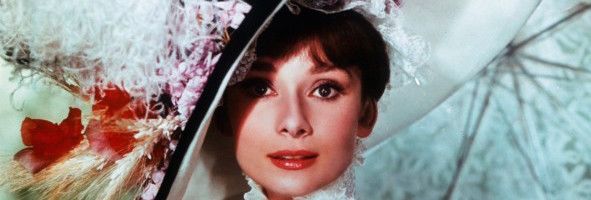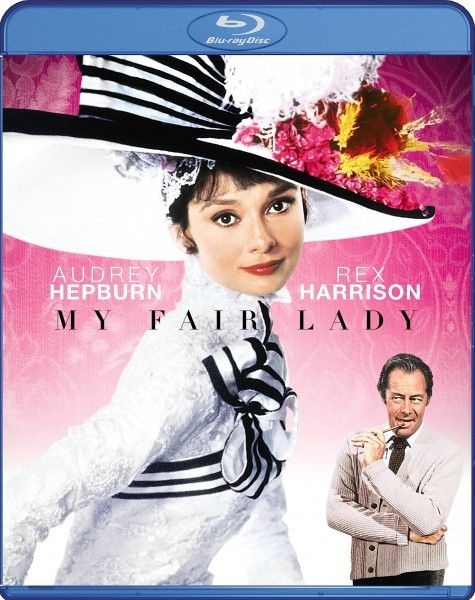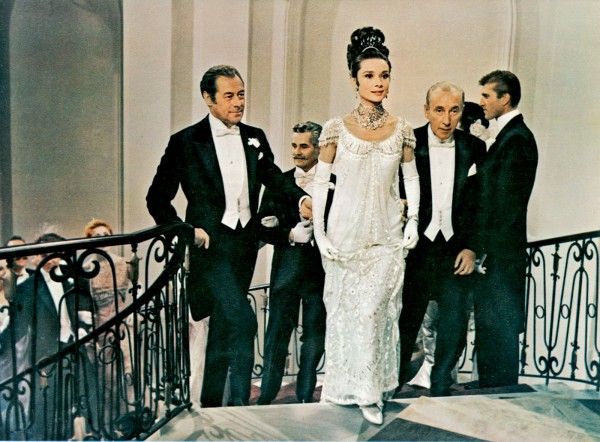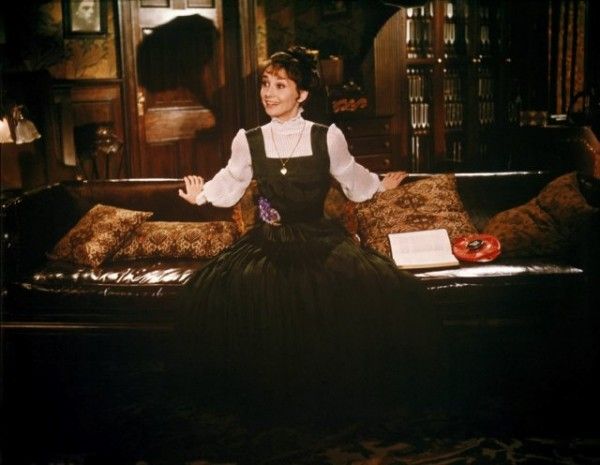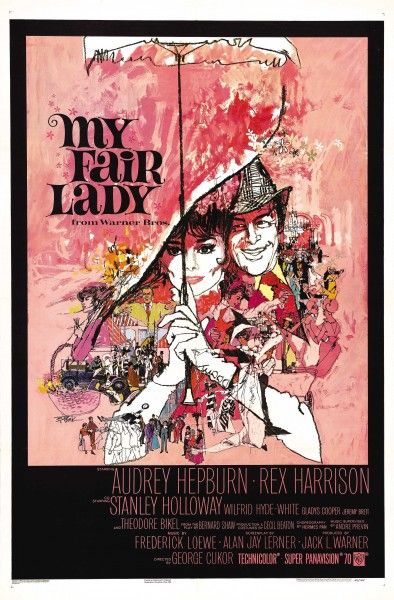In 1964 My Fair Lady won best picture, and it’s a film very much of its time. Based on a hit Broadway show, it was shot in Super Panavision 70mm and though it was shot entirely on the backstages of Warner Brothers, it’s meant to have a scope and scale that was meant to wow audiences who’d grown a little too accustomed to watching television. The film runs nearly three hours, has a number of very catchy songs, and is one of the better films of its type of musical.
Rex Harrison stars as Professor Henry Higgins, a dialect expert who tells his guest Colonel Hugh Pickering (Wilfred Hyde-White) that he can transform the speech of the lowest London peasant into someone that could pass for royalty. When a bet is made if it their test subject becomes Eliza Doolittle (Audrey Hepburn), a flower girl whose father Alfred (Stanley Holloway) is a drunk and womanizer. Higgins succeeds, but what that means for Eliza is hard for them to fathom, because Higgins doesn’t realize he’s fallen in love.
Because of the success of Rogers and Hammerstein on Broadway, and the subsequent blockbuster film adaptations of those musicals, during the 1950’s and 60’s Hollywood began making bigger and bigger musicals the way they now are trying to build franchises out of every narrative. The problem is that the majority of these films aren’t great movies: They tend to feel like stage adaptations, with little visual wit and you can often tell when the music’s about to start when you hear that switch on the audio track that reveals the performers are about to mouth along to the pre-record. These were the musicals I was most exposed to as a kid and it’s the reason why I – like so many dumb males – thought the entire musical genre was not for me. What I didn’t know was the works of people like Fred Astaire and Gene Kelly, and the beauty that could be found in their dancing, and in the films of Busby Berkley. Finding those films later was revelatory, while these films felt like something only moms would like.
It’s worth pointing out that this style of musical almost killed Hollywood as they made a number of big budget bombs chasing the success films like My Fair Lady and Sound of Music had. It was a rare chemistry, but revisiting these films today, they don’t represent the highs of cinema, much as the most successful movies of the year are rarely the best films. Perhaps these films played like a better version of touring companies doing the big hits from Broadway. They were never meant to be simply films, but a well done adaptation of what worked on stage, and much cheaper to go to than 42nd Street.
My Fair Lady is a filmed play, with Harrison and Holloway playing the parts they did in the Broadway version, and with Hepburn replacing Julie Andrews in the lead role. As directed by George Cukor, the film, perhaps partly encumbered by the 70mm cameras, is kept to limited locations and never achieves much visual panache. You’re more likely to revel in the woodwork in Higgins’ home than the camera work. Running 173 minutes (with restoration credits), it’s a film that might work better in a theater, as you can fall into it, and can’t look at your phone - it’s leisurely paced and not that much happens. But it’s also the sort of film where the performers are perfectly cast and though it’s not my favorite Hepburn or Harrison film, they are perfect within those roles.
I guess I’m giving the film a soft pass because compared to the musicals of this genre that don’t work (and there are a number, including Star! and Paint Your Wagon), this is one of the best examples of a type of musical I don’t care for.
The film is presented widescreen (2.20:1) and in Dolby Digital 7.1 TrueHD. The film was restored twenty years ago, and the work done then was amazing, while it seems a great deal of work went into this Blu-ray transfer. It’s immaculate, and improves remarkably over the previous Blu-ray release. The film comes in a three disc set, with the film on disc one, supplements on the second, and a DVD copy of the film on the third.
Disc 2 is stuffed with all the supplements. It kicks off with “More Loverly Than Ever: The Making of My Fair Lady Then and Now” (58 min.), which gets people like magazine founder Grace Mirabella, Andrew Lloyd Webber, Stanley Holloway’s son Julian Holloway, Martin Scorsese, and is hosted by Jeremy Brett, who played Freddy Eynsford-Hill. This supplement was done in 1995 (the year of Brett’s death), which explains why this piece on the film’s restoration presents clips of the film in pan and scan. It walks through both the production, the controversy of Julie Andrews not getting to reprise her role as Eliza Doolittle for the big screen (with comments from Andrews herself), and the film’s restoration. “1963 Kick Off Dinner” (23 min.) offers a look at a party with the cast and crew, and features interviews with Audrey Hepburn, Rex Harrison, and Jack Warner, with Warner giving a fascinating speech at the end. The interviewer is spectacularly rude and it suggests junket interviews have always been terribly awkward. It’s followed by footage from the “Los Angeles Premiere 10/28/64” (5 min.) which shows that all the stars showed up for the film’s premiere, including Frank Sinatra, Natalie Wood, Steve McQueen and more.
It’s followed by footage from the “British Premiere” (2 min.) which is in color and offers stars like Vivien Leigh, Rex Harrison and Audrey Hepburn – none of whom were at the Hollywood premiere. “George Cukor Directs Baroness Bina Rothschild” (3 min.) offers audio of the director coaching the performer on how to deliver her dialogue. The “Rex Harrison Radio Interview” (1 min.) has the actor pimping the film on a supposed phone call. “Production Tests” (7 min.) show tests done for the film’s lighting (because of concerns about how the 70mm would look), Wilford Hyde-White’s make up, a rain sequence, of a wet street, and a screen test. This is all narrated by Alex Hyde-White (the actor’s son).
Then there’s two Audrey Hepburn vocals for “Show Me” (3 min.) and for “Wouldn’t It Be Loverly” (5 min.), which is fascinating as Hepburn’s song were performed in the film by Marnie Nixon. It’s followed by “Comments on a Lady” with Andrew Lloyd Webber (1 min.) and Martin Scorsese (1 min.), though Scorsese talks more about restoration and preservation than the film itself. This is followed by four still galleries, for Cecil Beaton Sketches, Black and White Stills, Color Production Stills and Documents and Publicity. There’s seven teaser trailers, two original trailers, and four re-release trailers. It’s followed by three theatrical featurettes: “The Story of a Lady” (5 min.) “Design of a Lady” (8 min.) and “The Fairest Fair Lady” (10 min.). Done around the time of the film’s release, they highlight the costumes, music, and Jack Warner. In the awards section there’s footage of “Rex Harrison’s BFI Honor” (2 min.), Rex Harrison’s Golden Globe Acceptance Speech” (1 min.), and “Academy Awards Ceremony Highlights 4/5/65” (2 min.) which shows the film winning best director, picture and actor.

